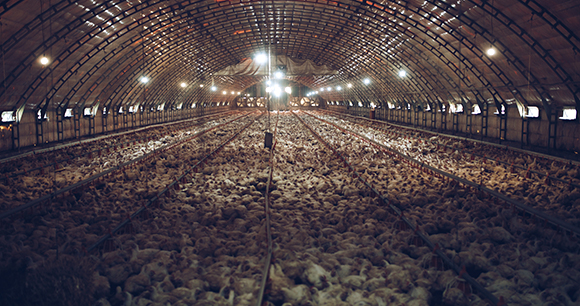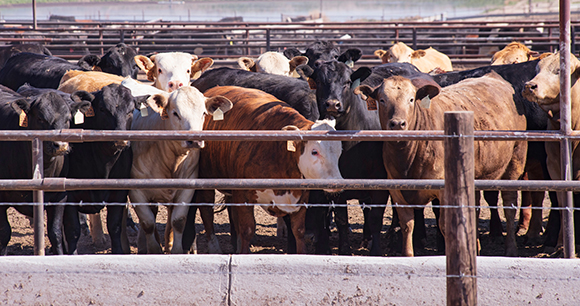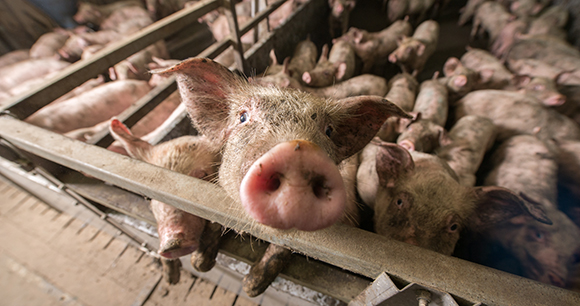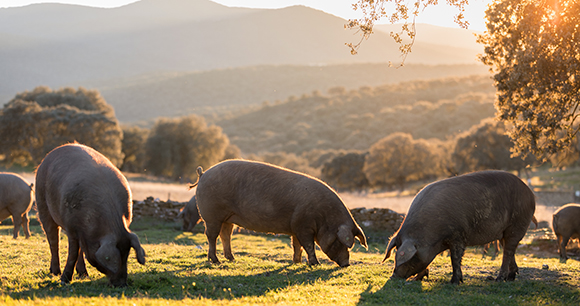On November 5, 2002, voters in Florida approved the first US law prohibiting the use of small “gestation crates” to house pregnant sows. Such crates are but one example of the extreme animal confinement that is a standard feature of concentrated animal feeding operations (CAFOs, a.k.a. “factory farms”). In this article, AWI examines what progress has been made over the past two decades toward replacing factory farming with a more humane and sustainable food system.
Farms Continue to Decline in Number and Grow in Size
The consolidation of the animal agriculture industry that began in the 1970s has continued. Just four meat companies—Cargill, Tyson, JBS, and National Beef Packing—now control 55 to 85 percent of the pork, beef, and chicken markets in the United States. This has contributed to the loss of thousands of small and medium-sized farms, and a continued shift from an independent system of farming to a corporate contract model (in which individual farmers have little say over how the animals are reared on their land). According to the US Department of Agriculture, the number of US dairy farms dropped from 125,000 in 1997 to under 55,000 in 2017, and the number of hog farms declined from 125,000 to 66,000.

With this consolidation has come a dramatic increase in the number of animals housed at individual locations. While animal mistreatment is known to occur on farms of all sizes, the largest operations are far less likely to provide animals with adequate space and access to range or pasture, and far more likely to subject them to painful procedures. Moreover, large operations are ill-equipped to protect and humanely handle animals during major disasters or disease outbreaks. On multiple occasions in the past few years, a quarter of a million birds or more have died in barn fires at a single location. And the detection of avian influenza in one egg-laying hen has led to the intentional “depopulation” of millions of birds at a production facility—usually via cruel methods—to prevent further spread.
Challenging the Operation of Factory Farms
Factory farms were largely unregulated 20 years ago, and they remain so today. There are no national standards for where or how a CAFO may be built. Instead, CAFOs are governed by a patchwork of state and local laws—most often designed not to hold them accountable but to further entrench them in American society.
All 50 states have enacted some form of right-to-farm law to thwart lawsuits against operations engaged in standard farming practices that result in “nuisance” conditions—noises, odors, pollutants, etc. inflicted upon neighbors. These statutes and their beneficiaries have been challenged extensively in southeastern states, where massive pig and chicken operations contaminate community water and foul the air with their waste and stench. Such efforts have met with little success, however, as the legal landscape in these states overwhelmingly favors industrial agriculture—not the rural homeowners who must endure a neighboring CAFO’s unwholesome output.
Many states have sought to further shield factory farms from scrutiny by creating laws that criminalize whistleblower activities such as recording or photographing the abysmal conditions that farm animals typically face. Because exposing the cruel realities of factory farming is a critical tool used by investigators, these laws have been the subject of dozens of lawsuits. Courts have largely agreed with advocates that these “ag-gag” laws violate the First Amendment. Ag-gag laws have been overturned in Idaho, Iowa, Kansas, North Carolina, Utah, and Wyoming, but they remain in force in several other states.
Animal and environmental advocates have sometimes used environmental and zoning laws to slow down or even stop CAFOs from being built. Diligent advocates monitor state and local processes to ensure that laws are followed and that public concerns are aired. In some cases, enough opposition is generated to cancel construction plans. Bills have also been introduced at both the state and federal level to limit or ban CAFOs. One current federal bill—the Farm System Reform Act, introduced by Senator Cory Booker (D-NJ) and Representative Ro Khanna (D-CA)—would prohibit the construction of new large CAFOs and the expansion of those currently operating.
Reforming Conventional Animal Care Practices
Painful Procedures
In the past 20 years, concern about painful procedures performed on farm animals has grown substantially, and the routine use of some procedures has decreased. But most farm animals are still subjected to one or more painful physical alterations over the course of their lives, typically at a young age. These include castration of all mammalian species, dehorning of dairy cattle and goats, tail docking of sheep and pigs, branding of cattle, teeth clipping of pigs, and beak trimming of both egg-laying hens and breeding chickens.
Historically, pain medication was never used; even today, its use varies widely between animal industries. The egg and poultry industries show no interest in managing pain with medication, although industry guidelines now at least acknowledge that beak trimming (used to control cannibalism and other aggressive behaviors triggered by the crowded, unnatural conditions) does cause pain, and producers are encouraged to breed more docile birds to decrease reliance on beak trimming.
Cattle are currently the species most likely to receive pain medication, especially if the procedure is performed by a veterinarian. In one study, over three-quarters of cattle veterinarians surveyed reported an increase in their use of pain relief between 2008 and 2018. However, most procedures are performed by the producers themselves, of whom only 32 percent reported increased analgesic use over this period. In another study, over half of veterinarians reported providing pain relief for castrations and dehorning some or all of the time, while most producers reported they never do so.

With pigs, nearly all males are castrated within a week of birth, and pigs of both sexes frequently undergo procedures that can cause chronic pain, such as tail docking and teeth clipping. In the United States, there is virtually no use of anesthetics or analgesics for these procedures. However, tail docking and teeth clipping are becoming less routine, and the pork industry is participating in research that should hasten the development of FDA-approved drugs to decrease piglet castration pain.
Growth Promotants
Growth promotants are another tool employed to facilitate intensive animal production by increasing the rate of weight gain or milk production. Their use can have harmful effects on animal welfare. For example, the administration of bovine growth hormone (BGH) to dairy cattle is associated with a 25 percent higher risk of mastitis (a painful udder infection) and a 55 percent higher risk of lameness. Fortunately, since 2002, BGH use has gradually decreased; by 2014—the year of the USDA’s most recent dairy survey—one-third fewer cows were receiving it.
Even bigger declines have been seen with the “beta-agonist” class of growth promotants used in pigs and cattle raised for meat. In cattle, drugs in this class increase mortality rates and lameness. In pigs, they increase stress levels, aggression, hoof lesions, and risk of becoming unable to walk. As of 2012, just over a quarter of grower-finisher pig operations used the beta-agonist ractopamine. Since that time, many major US trading partners, including China and EU member countries, have banned the use of ractopamine, prompting the largest US pork suppliers, including JBS, Smithfield, Hormel Foods, and Tyson foods, to ban ractopamine in their supply chains.
Antibiotics
The most controversial animal health practice over the past 20 years has been the use of antibiotic drugs. In the United States, the vast majority of antibiotics have long been administered not to humans but to animals used in food production, often in “subtherapeutic” doses to spur growth rather than treat infections. The widespread use of antibiotics on farms has contributed to an increase in resistance of bacterial pathogens to antibiotics that are medically important to humans.
Consumer pressure on grocery stores, restaurants, suppliers, and farmers has been a driving force in corporate decisions to reduce agricultural use of antibiotics. Despite some positive developments, however, there is ongoing cause for concern.
The Food and Drug Administration did not even begin tracking the sale of antibiotics in animal agriculture until 2008 (and only in 2016 issued a rule that required reporting by species). In 2012, the FDA released guidance on voluntary measures for limiting use of medically important antibiotics, and in 2017, new regulations went into effect banning their use as growth promoters.
After a 26 percent increase in the agricultural use of medically important antibiotics from 2009 to 2015, such use declined by 38 percent from 2015 to 2020 (resulting in a net decline of 22 percent from 2009 to 2020). The poultry industry has achieved the greatest reduction, while use in pigs and cattle remains high. Although the use of medically important antibiotics for growth promotion has been banned, the therapeutic use of antibiotics (i.e., to treat infections—including those caused or exacerbated by intensive production conditions) has increased, and there are few restrictions on the use of medically important antibiotics for this purpose. New restrictions also do not address the prophylactic use of antibiotics to prevent infections. Finally, antibiotics not currently considered medically important can still be used as growth promoters.
Ending Extreme Confinement
A hallmark of industrialized animal agriculture is the extreme confinement of animals. Egg-laying hens in battery cages, breeding sows in gestation crates, and veal calves tethered or in crates have caught the public’s attention, leading to attempts to curtail these common industry practices. Since the successful 2002 ballot initiative in Florida, more than a dozen prohibitions on extreme confinement have passed via state legislatures and ballot measures.

Although the specific language differs, these laws generally ban the confinement of animals in cages and crates. Ten states have prohibited the confinement of pregnant sows in a manner that does not allow them to stand up, lie down, and turn around without touching the sides of the enclosure. Seven states have prohibited confining veal calves in a similar manner. The livestock care regulations of two states go further by mandating that veal calves be kept in groups, a housing method that addresses not only extreme confinement but also social isolation of these young animals. The American Veal Association now requires its members to house calves in groups after 10 weeks of age. Depending on the state, however, the calves may be confined individually for those first weeks.
Nine states have prohibited the extreme confinement of egg-laying hens. Some laws require housing that allows hens to lie down, stand up, fully extend their wings, and turn around. Others mandate a minimum amount of usable floor space per hen, plus enrichment (such as perching, scratching, and foraging areas). The remainder merely require compliance with United Egg Producer’s relatively weak cage-free housing standards. Some state anti-confinement laws also ban the sale of animal products from any facility, in state or out, that engages in forms of confinement prohibited by the law. California and Massachusetts, for example, ban the sale of veal, pork, and eggs from animals raised in intensive confinement, regardless of origin.
In 2020, when AWI researched the impact of state farm animal welfare laws, there was no evidence that any of these laws had been the subject of enforcement actions, with the exception of the sales bans, which led to only three enforcement actions. Sales bans can have substantial effects on the market, and the industry has worked hard to challenge them in court, claiming they discriminate against out-of-state producers in a manner that violates the Constitution’s Commerce Clause. The US Supreme Court will soon consider a challenge to California’s sales ban (see page 12), and the outcome will have implications for the future of all state sales bans.
While the increase in state laws banning extreme confinement is encouraging, the largest production states—where the industry has enormous political sway—have not followed suit, meaning that the vast majority of animals in food production are not covered. For example, only 3 percent of pigs in the United States are covered by gestation crate bans (and there are no bans on farrowing crates, which confine sows from late pregnancy until weaning of the piglets). To date, the animals most impacted by anti-confinement laws are hens. As of April 2022, 28 percent of laying hens were in cage-free housing, up from 10 percent just six years ago.
Hundreds of producers, retailers, and distributors have also pledged to rid their supply chains of products from animals kept in extreme confinement. Over 50 companies, including McDonald’s, Burger King, Kroger, Safeway, and Costco, have adopted policies to eliminate gestation crates from their supply chains over various timelines. Over 100 companies have pledged to source only cage-free eggs. While this is indeed an encouraging trend, the follow-through on these commitments remains less than perfect.
The Growth of Alternative Farming Models
Even as large, industrial-scale farming has continued to expand over the past 20 years, awareness has grown over the detrimental impact of this type of production on animal welfare, the environment, and local communities. Consumers have begun demanding more from companies in terms of animal welfare and sustainability, leading to the emergence and growth of alternative systems that aim to produce food more closely aligned with the values of conscientious consumers.
Many companies are taking steps to respond to consumer demands for more ethically produced food by implementing practices that improve animal welfare. One example is the growing use of free-range and pasture-raising systems within the poultry and egg industries. The Associated Press has reported that over 8 million egg-laying hens are currently being reared free-range or on pasture. One of the nation’s largest chicken producers, Perdue Farms, recently announced it now provides at least 25 percent of its chickens with outdoor access.

Additional production methods with the potential to improve farm animal welfare are organic and regenerative agriculture. While organic production has been around for quite some time, the USDA has recently committed to reviving the minimum welfare standards (withdrawn in 2017) for farm animals raised under the National Organic Program. These regulations would improve the lives of millions of farm animals, as well as increase the selection of higher-welfare products available to consumers. Regenerative agriculture builds on organic principals by focusing on soil health and ecological outcomes, while incorporating organic animal-raising practices. Farms committed to regenerative agriculture reject the conventional CAFO model and prioritize raising animals on pasture so they can graze the land and live more naturally.
To distinguish their higher-welfare products from those produced from animals raised on factory farms, many companies are pursing third-party certification. To qualify for certification, producers must undergo audits that ensure compliance with established animal care standards. In the years since AWI founded the Animal Welfare Approved certification program, several other nonprofit programs have been launched to improve farm animal welfare. Today, the three largest certification programs verify the treatment of 1.5 billion—one out of every six—farm animals in the United States. While the strength of the programs varies, all feature standards above those of the conventional animal agriculture industry.
The past 20 years has seen both advances and setbacks in the effort to eliminate factory farms and transition to a more ethical food system. While the animal agriculture industry has not voluntarily made significant improvements to its animal care practices, state legislation and ballot initiatives, along with corporate commitments, are raising standards for many farm animal species. Alternative forms of animal agriculture have also grown in popularity. However, it remains unlikely that most farm animals will be raised under higher-welfare conditions any time soon. In addition to supporting legal reforms, individuals can play a role in achieving this transition by reducing their consumption of food from animals and avoiding any products from animals raised on CAFOs. Learn more about what to look for at the store with AWI’s A Consumer’s Guide to Food Labels and Animal Welfare.
Take action! Please urge your representative and senators to cosponsor the Farm System Reform Act (HR 4421 /S 2332), a bill that would phase out the largest factory farms and provide opportunities for farmers to transition to higher welfare farming or crop production. You can contact your legislators through AWI’s online Action Center or by writing them at The Honorable [full name], US House of Representatives, Washington, DC 20515 and The Honorable [full name], US Senate, Washington, DC 20510.